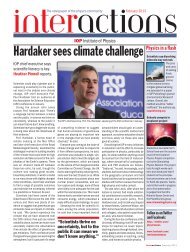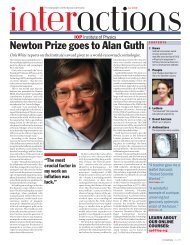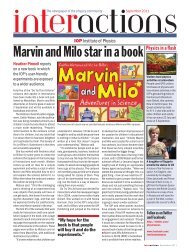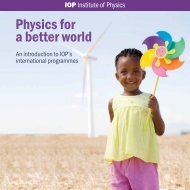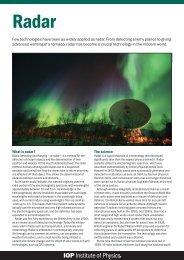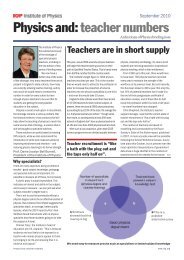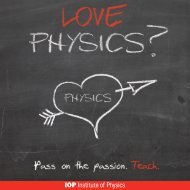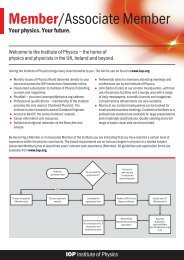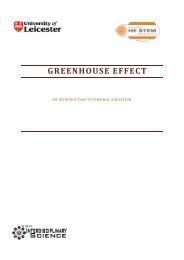Girls in the Physics Classroom: A Teachers' Guide - Institute of Physics
Girls in the Physics Classroom: A Teachers' Guide - Institute of Physics
Girls in the Physics Classroom: A Teachers' Guide - Institute of Physics
You also want an ePaper? Increase the reach of your titles
YUMPU automatically turns print PDFs into web optimized ePapers that Google loves.
2: Lessons from research<br />
9. The f<strong>in</strong>d<strong>in</strong>gs referred to here<br />
come from sections 4 and 5 <strong>of</strong><br />
Murphy and Whitelegg’s report.<br />
● measurement taker<br />
● data recorder<br />
You may need to consider whe<strong>the</strong>r all students will feel<br />
confident <strong>in</strong> <strong>the</strong> different roles. You could <strong>in</strong>troduce a mentor<strong>in</strong>g<br />
scheme, where a student takes responsibility for<br />
hand<strong>in</strong>g over a role and support<strong>in</strong>g ano<strong>the</strong>r student.<br />
Support<strong>in</strong>g learn<strong>in</strong>g <strong>in</strong> groups<br />
If you noted your own or colleagues’ <strong>in</strong>terventions dur<strong>in</strong>g<br />
your observations with students, you could reflect on <strong>the</strong>se<br />
to consider <strong>the</strong> characteristics <strong>of</strong> effective <strong>in</strong>teractions and<br />
<strong>the</strong> students that <strong>the</strong>y work for. Look at your notes:<br />
● Which <strong>in</strong>terventions were successful?<br />
● What were <strong>the</strong> characteristics <strong>of</strong> successful<br />
<strong>in</strong>teractions (i.e. what was <strong>the</strong>ir purpose and content)?<br />
● What roles did <strong>the</strong>y place <strong>the</strong> student <strong>in</strong>, <strong>in</strong> relation to<br />
<strong>the</strong> teacher (follower <strong>of</strong> <strong>in</strong>structions, decision maker)?<br />
● What k<strong>in</strong>d <strong>of</strong> help did you have to give with plann<strong>in</strong>g<br />
and execut<strong>in</strong>g <strong>the</strong> activity?<br />
● Did <strong>the</strong> help differ for boys and girls?<br />
● Were some <strong>in</strong>terventions more effective with boys or<br />
girls, or with some girls?<br />
Tak<strong>in</strong>g account <strong>of</strong> students’ views <strong>of</strong> tasks<br />
In your observations you may have noticed that students<br />
differed <strong>in</strong> <strong>the</strong> sense that <strong>the</strong>y made <strong>of</strong> <strong>the</strong> tasks that you<br />
set. If you noticed differences, you might beg<strong>in</strong> an <strong>in</strong>vestigation<br />
or experiment by talk<strong>in</strong>g through a plann<strong>in</strong>g activity<br />
with <strong>the</strong> whole class. In <strong>the</strong> discussion:<br />
● encourage students to <strong>of</strong>fer ways <strong>of</strong> tackl<strong>in</strong>g <strong>the</strong> task<br />
ra<strong>the</strong>r than settl<strong>in</strong>g quickly on <strong>the</strong> “right” approach;<br />
● ask students first to state <strong>the</strong>ir understand<strong>in</strong>g <strong>of</strong> <strong>the</strong><br />
task (i.e. what it is <strong>the</strong>y are f<strong>in</strong>d<strong>in</strong>g out for what<br />
purpose) and <strong>the</strong>n to describe <strong>the</strong>ir approach;<br />
● critique <strong>the</strong> approach <strong>in</strong> relation to <strong>the</strong> students’ task<br />
and purpose;<br />
● expla<strong>in</strong> <strong>the</strong> task and purpose you have <strong>in</strong> m<strong>in</strong>d and <strong>the</strong><br />
reasons for this focus.<br />
In this way, students’ different ideas can be expressed<br />
and validated at <strong>the</strong> same time as help<strong>in</strong>g <strong>the</strong>m to see why<br />
physics tasks have particular purposes and approaches.<br />
Students’ perceptions about tasks might <strong>of</strong>fer you some<br />
ideas for alternative tasks and approaches that broaden<br />
<strong>the</strong>ir experience <strong>of</strong> physics and extend <strong>the</strong>ir access to it.<br />
2.3 The teacher perspective 9<br />
Did you know?<br />
Teacher–student relationships<br />
● A major <strong>in</strong>fluence on students’ attitudes to physics is<br />
<strong>the</strong> teacher-student relationship, particularly for girls. A<br />
positive attitude is associated with a supportive personal<br />
relationship.<br />
● Students value strong leadership, friendl<strong>in</strong>ess and<br />
understand<strong>in</strong>g <strong>in</strong> <strong>the</strong>ir teachers but <strong>the</strong>y are more likely<br />
to experience <strong>the</strong>se qualities <strong>in</strong> subjects o<strong>the</strong>r than<br />
science and maths. Large classes are not conducive to<br />
positive teacher–student relationships.<br />
● Evidence from research shows that girls still receive<br />
less teacher attention <strong>in</strong> science classes than boys.<br />
Teachers are more likely to allow boys to dom<strong>in</strong>ate<br />
discussion as a means <strong>of</strong> controll<strong>in</strong>g <strong>the</strong>ir behaviour.<br />
● <strong>Girls</strong> are more likely than boys to receive feedback on<br />
<strong>the</strong> quality <strong>of</strong> <strong>the</strong>ir work ra<strong>the</strong>r than on <strong>the</strong>ir behaviour.<br />
Boys receive more than girls – positive and negative.<br />
Negative feedback is typically about boys’ behaviour.<br />
● This difference <strong>in</strong> feedback has been associated with<br />
girls’ tendency to underestimate <strong>the</strong>ir achievements <strong>in</strong><br />
physics and science relative to boys. Teachers<br />
reported that <strong>the</strong>y were not aware <strong>of</strong> differences <strong>in</strong> <strong>the</strong>ir<br />
treatment <strong>of</strong> girls and boys.<br />
● Teachers’ beliefs about student abilities have a<br />
significant affect on how students view <strong>the</strong>ir own<br />
abilities. There is evidence that teachers have lower<br />
expectations <strong>of</strong> girls <strong>in</strong> physics, even those girls who<br />
cont<strong>in</strong>ue to study physics post-16.<br />
Teach<strong>in</strong>g strategies<br />
● Students, particularly girls, value teach<strong>in</strong>g approaches<br />
that give <strong>the</strong>m responsibility for <strong>the</strong>ir learn<strong>in</strong>g, and <strong>the</strong><br />
chance to make decisions and th<strong>in</strong>k for <strong>the</strong>mselves.<br />
● Teach<strong>in</strong>g strategies associated with <strong>in</strong>creased<br />
motivation and achievement for girls and that also<br />
ma<strong>in</strong>ta<strong>in</strong> and enhance boys’ achievements <strong>in</strong>clude<br />
<strong>in</strong>vestigative practical work; problem solv<strong>in</strong>g and<br />
project-based activities; and group and class<br />
discussion that gives value to alternative views and<br />
approaches to tasks.<br />
● <strong>Girls</strong> are particularly responsive to collaborative group<br />
work when <strong>the</strong> teacher manages <strong>the</strong> roles carefully.<br />
● S<strong>in</strong>gle-sex groups can have a positive effect on<br />
students’ views about <strong>the</strong>ir ability <strong>in</strong> physics and <strong>the</strong>ir<br />
take-up <strong>of</strong> physics courses. However, if s<strong>in</strong>gle-sex<br />
teach<strong>in</strong>g is to be effective, research shows that<br />
teachers need to be aware <strong>of</strong> gender issues and<br />
committed to gender-<strong>in</strong>clusive teach<strong>in</strong>g. O<strong>the</strong>rwise, it<br />
is possible that s<strong>in</strong>gle-sex group<strong>in</strong>gs will have little, or<br />
even a detrimental, effect.<br />
Could this be happen<strong>in</strong>g <strong>in</strong> your school?<br />
Some questions to consider:<br />
● Do you consider that physics classrooms <strong>in</strong> your<br />
16 I NSTITUTE OF P HYSICS R EPORT G IRLS IN THE P HYSICS C LASSROOM: A TEACHERS’ GUIDE FOR A CTION D ECEMBER 2006




